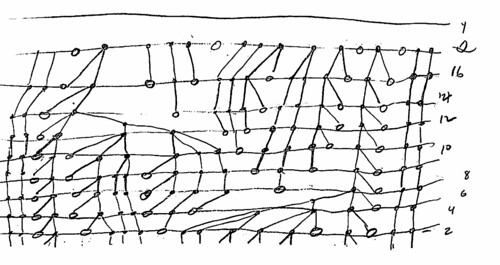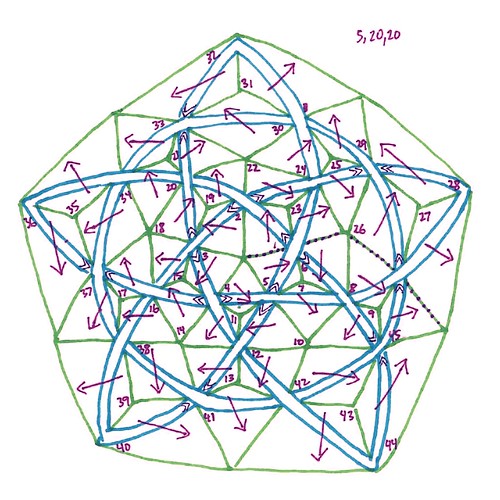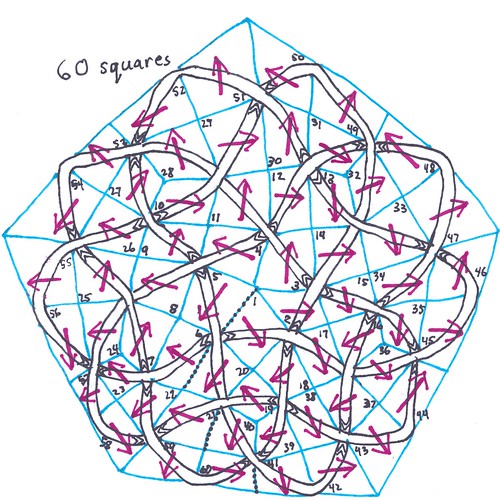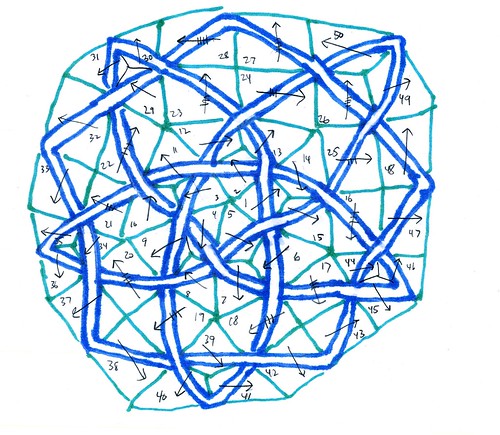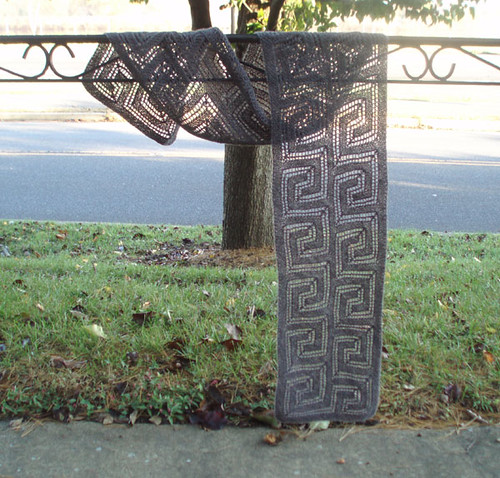I'm really pleased with the way this diagram came out. The little "x"s correspond to missing stitches--rows 4, 6, 12, and 14 have 17 stitches and the rest of the rows have 19. Except for rows 5 and 13, which have 15 stitches, but I didn't want to indicate that.
Not that this diagram shows how the piece looks knitted, but it does point out the structure of the pattern, and points out a way to make the pattern bigger, and, possibly, how to chart an upside-down version of the pattern, which one of my readers has been trying to figure out.
Monday, November 30, 2009
Dayflower Diagram, neatened
Sunday, November 29, 2009
Double-increase variations
If you diagram it without indicating the way the threads cross, it looks like this.

Without showing how the threads cross, it’s not clear what structure is being created. So, I thought, what are the possible ways to pull three loops through another loop? I have found three essentially different ways (that don't involve twisting the original loop). Two of them have a reverse side that looks different.
1. First is the knit-one-yarnover-knit-one that’s familiar:

You can create this same structure by performing a purl-one-yarnover-purl-one on a reverse-side row.
2. Another is knit-one-yarnover-purl-one. This is a completely reversible structure. It looks the same and is created the same way on both sides of the fabric:

If you do purl-one-yarnover-knit-one, you get the mirror image of the diagram above.
3. A new (?) one is what I tentatively call a knit-squared. You pull a loop through a loop towards you as in knitting, and while keeping the “legs” of the new loop as separate loops, pull the head of the new loop through the old loop towards you again. I am not sure how to efficiently produce it in hand knitting, but the structure is like this:

These are the three different structures (I don’t count the reverse sides of this as different) I’ve found to “disambiguate” the first diagram.
Wednesday, November 25, 2009
"Dayflower" Diagram
All my attempts to diagram this pattern, from Barbara Walker's Lace Knitting book, had failed. This is a drastically simplified version that I was at least able to complete. Now for the neatening-up.
Just sharing my process, folks. It's ugly.
Tuesday, November 17, 2009
most-of-icosidodeca-cabled-entrelac-45-sq
This closed-loop cabled entrelac shape is based on the icosidodecahedron. The cables follow the edges of the Archimedean solid, but not all edges are used.
The goal with this shape was to keep 6 of the pentagons with the triangles that surround them. If this becomes a hat, I'm hoping that you'll be able to see the pentacle at the crown and 5 pentacles around the sides of the hat.
All of the triangles formed by the cables are the same size when knitted, perhaps stretched out a bit when the knitted piece is worn. We shall see.
Sunday, November 15, 2009
Thursday, November 12, 2009
Continuous-loop cable design, Part 2
- Cables can cross where 4 entrelac squares meet at their corners.
- Any regular polygon can be decomposed into (possibly distorted) squares.
- Where polygons so decomposed share an edge, 4 squares meet at their corners.
- Fill in the cables for a tasty continuous-cable treat.
Continuous-loop cable design
The type of knitting I've been complicating lately is a style I call "Continuous Loop Cable Entrelac."
The design goals of this type of knitting are these:
1. produce knitted cables that appear to have no beginning and no end.
2. make these cables with one continuous thread of yarn.
3. minimize grafting.
The way I solved this challenge was to knit entrelac squares that bear diagonal cables. The cables can cross each other where the corners of four squares come together.
The simplest continuous loop would be a simple, uncrossed loop. Such a loop can be created with four entrelac squares that bear diagonal cables.
With a simple loop the beginning and end of the continuous cable have nowhere to hide. It would be possible to graft the beginning and end together, and that's a legitimate choice, but it conflicts with design goal 3.
To avoid grafting the cable itself, the simplest possible loop is a figure-8. With this shape, I can hide the beginning and ending of the cable under a cable crossing.
Figure-8 loop in continuous loop cable entrelac
1. Draw eight squares arranged in a two-by-four rectangle.
2. Indicate the grain of the knitting with a line in each square (this show how the squares are perpendicular to each other, without deciding on the direction of knitting yet.)
3. Draw in a diagonal cable on each square.
4. Draw in how the cables flow from and cross over each other.*
5. Indicate the direction of the cable with chevrons. The cable must start and end under a cable crossing to be able to appear continuous.
6. Indicate the direction of knitting the squares with arrowheads added to the lines in step 2.
7. Number the squares in order of knitting.
8. Diagram each square separately, showing its connections to previous squares.
When it comes time to present the diagram, I usually remove the chevrons I added to the diagram in step 5.
To be continued...
*There are generally two possible ways to do this; I usually have to try both ways to see which would be easier to knit.
double-pentacle-with-pentagon
Not my most symmetrical diagram, but shows an interesting interlacing of "continuous-loop" cables in entrelac. No idea how the cables will look in real life, probably more wavy than this diagram shows.
Saturday, November 07, 2009
Rounded pentacle
This was knit from the diagram I posted earlier. 15 squares joined together entrelac-style, with a cable across a diagonal of each square. It's unblocked. Where three squares meet the corners form shallow pyramids, which may block out.
Thursday, November 05, 2009
Greek Key Scarf
Wonderlywroughte on Ravelry just finished my Greek Key Scarf. It's fun to see someone else's take on my designs. Here is a link to download the pattern: download Greek Key Lace Scarf Pattern now.
Amigurumi Knits: Patterns for 20 Cute Mini Knits by Hansi Singh | LibraryThing

I just bought this book from KnitPicks during their 40%-off sale. I love this amigurumi stuff. Usually it's done with crochet, but here an inventive knitter has figured out techniques for knitting creatures of all kinds. You know you want to knit an octopus!

![Reblog this post [with Zemanta]](http://img.zemanta.com/reblog_e.png?x-id=03011537-5e58-4978-a00a-77451a94a651)
